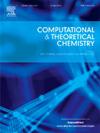利用Car-Parrinello分子动力学研究维生素B6的结构、溶解度和水溶液溶剂化
IF 3
3区 化学
Q3 CHEMISTRY, PHYSICAL
引用次数: 0
摘要
本研究旨在通过CPMD模拟来阐明水环境对吡哆醇几何和电子性质的影响。利用HS分析研究了晶体状态下的超分子排列,并通过比较固相和固相的内聚能计算来了解溶解过程。亥姆霍兹自由能计算证实,这些相互作用在热力学上是有利的,几何分析将它们归类为中等强度的氢键。电子密度的拓扑分析表明,稳定后,其中两个相互作用的强度从弱到中等,而其余两个相互作用的强度从弱到强。HS分析强调了分子间氢键的存在,这是形成锯齿状片状晶体网络结构的原因。内聚能评价支持了吡哆醇在水中溶解度的实验观察。这些发现为研究维生素B6在溶液中的分子行为提供了有价值的见解,从而增强了我们对其化学性质和生物活性的理解。本文章由计算机程序翻译,如有差异,请以英文原文为准。

Structural studies, solubility, and aqueous solvation of Vitamin B6 using Car-Parrinello Molecular Dynamics
This study aims to elucidate the influence of an aqueous environment on the geometric and electronic properties of pyridoxine through CPMD simulations. The supramolecular arrangement in the crystalline state was investigated using HS analysis, complemented by cohesive energy calculations comparing the solid and solution phases to understand the dissolution process. Helmholtz free energy calculations confirm that these interactions are thermodynamically favorable, with geometric analysis classifying them as moderately strong hydrogen bonds. Topological analysis of the electronic density revealed that two of these interactions range from weak to moderate in strength after stabilization, while the remaining two vary from weak to strong. HS analysis highlighted the presence of significant intermolecular hydrogen bonds, which are responsible for the formation of a zigzag-shaped, sheet-like crystalline network structure. Cohesive energy assessments support the experimental observation of pyridoxine's solubility in water. These findings provide valuable insights into the molecular behavior of vitamin B6 in solution, thereby enhancing our understanding of its chemical properties and biological activities.
求助全文
通过发布文献求助,成功后即可免费获取论文全文。
去求助
来源期刊

Computational and Theoretical Chemistry
CHEMISTRY, PHYSICAL-
CiteScore
4.20
自引率
10.70%
发文量
331
审稿时长
31 days
期刊介绍:
Computational and Theoretical Chemistry publishes high quality, original reports of significance in computational and theoretical chemistry including those that deal with problems of structure, properties, energetics, weak interactions, reaction mechanisms, catalysis, and reaction rates involving atoms, molecules, clusters, surfaces, and bulk matter.
 求助内容:
求助内容: 应助结果提醒方式:
应助结果提醒方式:


